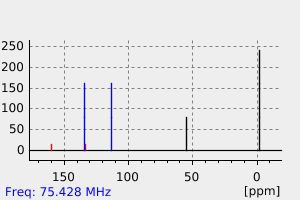(4-methoxyphenyl)trimethylgermane | 14476-81-4
中文名称
——
中文别名
——
英文名称
(4-methoxyphenyl)trimethylgermane
英文别名
Germane, (4-methoxyphenyl)trimethyl-;(4-methoxyphenyl)-trimethylgermane
CAS
14476-81-4
化学式
C10H16GeO
mdl
——
分子量
224.826
InChiKey
WKKOEYIQCIWDHN-UHFFFAOYSA-N
BEILSTEIN
——
EINECS
——
-
物化性质
-
计算性质
-
ADMET
-
安全信息
-
SDS
-
制备方法与用途
-
上下游信息
-
文献信息
-
表征谱图
-
同类化合物
-
相关功能分类
-
相关结构分类
计算性质
-
辛醇/水分配系数(LogP):2.24
-
重原子数:12
-
可旋转键数:2
-
环数:1.0
-
sp3杂化的碳原子比例:0.4
-
拓扑面积:9.2
-
氢给体数:0
-
氢受体数:1
SDS
反应信息
-
作为反应物:描述:(4-methoxyphenyl)trimethylgermane 在 sodium carbonate 作用下, 以 二氯甲烷 、 水 为溶剂, 反应 3.0h, 生成 8-((4-methoxyphenyl)-l3-iodanylidene)-6,10-dioxaspiro[4.5]decane-7,9-dione参考文献:名称:通过化学和位点选择性ipso取代反应合成功能化的单芳基-λ3-碘。摘要:单芳基-λ 3 -iodanes是潜在有吸引力的芳基化剂。它们通常是通过氧化从芳基碘化物合成的,这会引起官能团的不相容性,尤其是在需要多官能化衍生物的情况下。这项工作描述单芳-λ的直接合成3通过化学选择性-iodanes本位arylgermanes和arylstannanes与碘的3'-取代反应三(三氟乙酸盐)。将生成的碘化物转化为碘鎓碘化物,或在一锅中用于进一步转化。所提出的方法使多官能化的单芳基-λ的制备3 -iodanes。DOI:10.1002/chem.201805970
-
作为产物:描述:(4-methoxyphenyl)trimethylstannane 、 Me3GeLi 以 六甲基磷酰三胺 、 乙醚 为溶剂, 生成 (4-methoxyphenyl)trimethylgermane参考文献:名称:Mochida, Kunio; Kugita, Tsuyoshi, Nippon Kagaku Kaishi/Journal of the Chemical Society of Japan摘要:DOI:
文献信息
-
Palladium-Catalyzed N-Arylation of Amines and Amides with Aryltrimethylgermanes作者:Qiang Zhang、Lingxia Jin、Cunfang Liu、Juan Shi、Qiong Xu、Chaibin Zhao、Tianlei ZhangDOI:10.1055/s-0035-1562104日期:——Described herein is a novel palladium-catalyzed C–N bond-formation reaction employing aryltrimethylgermanes as the new arylating reagents. Primary/secondary amines or even amides could be smoothly arylated to provide the corresponding N-arylation products in moderate to excellent yields.
-
Palladium-Catalyzed Germylation of Aryl Bromides and Aryl Triflates Using Hexamethyldigermane作者:Narumi Komami、Keitaro Matsuoka、Tatsuhiko Yoshino、Shigeki MatsunagaDOI:10.1055/s-0037-1609301日期:2018.5Palladium-catalyzed germylation of aryl bromides and aryl triflates using commercially available hexamethyldigermane is described. Optimized reaction conditions afforded various functionalized aryltrimethylgermanes, including drug-like molecules, in moderate to good yields, demonstrating the versatility of the presented protocols. Palladium-catalyzed germylation of aryl bromides and aryl triflates using commercially
-
Synthesis and spectroscopic characteristics of aryltrimethyl-silicon, -germanium, and -tin compounds作者:S.M. MoerleinDOI:10.1016/0022-328x(87)80344-3日期:1987.1The synthesis and spectroscopic characteristics of 28 para-substituted aryltrimethyl-silicon, -germanium, and -tin compounds are described. The infrared spectra show characteristic bands at 1245–1165 (methyl bend), 840–765 (methyl rock), and 1105–1020 (in-plane aromatic H bend) cm−1; the frequency of the last band was found to depend on the sum of the aromatic substituent masses, the presence or absence
-
Regiospecific aromatic fluorodemetallation of group IVb metalloarenes using elemental fluorine or acetyl hypofluorite作者:H.H. Coenen、S.M. MoerleinDOI:10.1016/s0022-1139(00)82054-0日期:1987.6corresponding metallated anisyl- and toluyl- compounds were 2-fluoroanisole (< 16%) and benzylfluoride (< 5.5%). No direct hydrogen substitution was observed in the other substrates investigated. The high regiospecific fluorination yields obtained make aromatic fluorination of group IVb metallated arenes (especially of tin) a very attractive preparative fluorination and radio-labelling method.使用氟-18(T = 110分钟)作为放射化学示踪剂,研究了氟和次氟乙酰基次氟与三甲基芳基锡,-锗和-硅化合物的反应。亚化学计量比的F 2对苯基衍生物进行氟脱金属生成氟苯几乎与温度(-78°至22°C),反应时间(2至200分钟)和底物浓度(2至150 mM)无关。两种氟化剂的反应都不受全卤代甲烷作为溶剂的影响,但是在具有活性氢的溶剂中完全被抑制。在一系列对位取代的苯基衍生物中(CH 3 O-,CH 3-,H-,F-,Br-,CF 3-,O 2N-),观察到氟脱金属产率的降低,其顺序为Sn> Ge> Si,并且具有含吸电子基团的环。CH 3 CO 2 F与甲氧基化芳烃的反应性与F 2相等,但远低于F 2当使用芳基锗或-硅衍生物时。这些发现与涉及σ-复合物的替代机制是一致的。由相应的金属化的茴香基和甲苯基化合物形成的唯一副产物是2-氟茴香醚(<16%)和苄基氟化物(<5.5%)。在研究的其他
-
Mechanism and Selectivity of Aryltrimethylgermane Cation Radical Fragmentations作者:Elizabeth C. Feinberg、Joseph P. DinnocenzoDOI:10.1021/acs.joc.0c01032日期:2020.7.2Aryltrimethylgermane cation radicals were generated by nanosecond transient absorption spectroscopy. Transient kinetics experiments show that the aryltrimethylgermane cation radicals react with added nucleophiles in reactions that are first-order in both the cation radicals and the nucleophiles. Preparative photo-oxidation experiments demonstrate that the intermediate cation radicals react with nucleophiles
表征谱图
-
氢谱1HNMR
-
质谱MS
-
碳谱13CNMR
-
红外IR
-
拉曼Raman
-
峰位数据
-
峰位匹配
-
表征信息
同类化合物
(R)-3-(叔丁基)-4-(2,6-二异丙氧基苯基)-2,3-二氢苯并[d][1,3]氧杂磷杂环戊烯
(2S,3R)-3-(叔丁基)-2-(二叔丁基膦基)-4-甲氧基-2,3-二氢苯并[d][1,3]氧杂磷杂戊环
(2S,2''S,3S,3''S)-3,3''-二叔丁基-4,4''-二甲氧基-2,2'',3,3''-四氢-2,2''-联苯并[d][1,3]氧杂磷杂戊环
(2R,2''R,3R,3''R)-3,3''-二叔丁基-4,4''-二甲氧基-2,2'',3,3''-四氢-2,2''-联苯并[d][1,3]氧杂磷杂戊环
(2-氟-3-异丙氧基苯基)三氟硼酸钾
(+)-6,6'-{[(1R,3R)-1,3-二甲基-1,3基]双(氧)}双[4,8-双(叔丁基)-2,10-二甲氧基-丙二醇
麦角甾烷-6-酮,2,3,22,23-四羟基-,(2a,3a,5a,22S,23S)-
鲁前列醇
顺式6-(对甲氧基苯基)-5-己烯酸
顺式-铂戊脒碘化物
顺式-四氢-2-苯氧基-N,N,N-三甲基-2H-吡喃-3-铵碘化物
顺式-4-甲氧基苯基1-丙烯基醚
顺式-2,4,5-三甲氧基-1-丙烯基苯
顺式-1,3-二甲基-4-苯基-2-氮杂环丁酮
非那西丁杂质7
非那西丁杂质3
非那西丁杂质22
非那西丁杂质18
非那卡因
非布司他杂质37
非布司他杂质30
非布丙醇
雷诺嗪
阿达洛尔
阿达洛尔
阿莫噁酮
阿莫兰特
阿维西利
阿索卡诺
阿米维林
阿立酮
阿曲汀中间体3
阿普洛尔
阿普斯特杂质67
阿普斯特中间体
阿普斯特中间体
阿托西汀EP杂质A
阿托莫西汀杂质24
阿托莫西汀杂质10
阿托莫西汀EP杂质C
阿尼扎芬
阿利克仑中间体3
间苯胺氢氟乙酰氯
间苯二酚二缩水甘油醚
间苯二酚二异丙醇醚
间苯二酚二(2-羟乙基)醚
间苄氧基苯乙醇
间甲苯氧基乙酸肼
间甲苯氧基乙腈
间甲苯异氰酸酯







